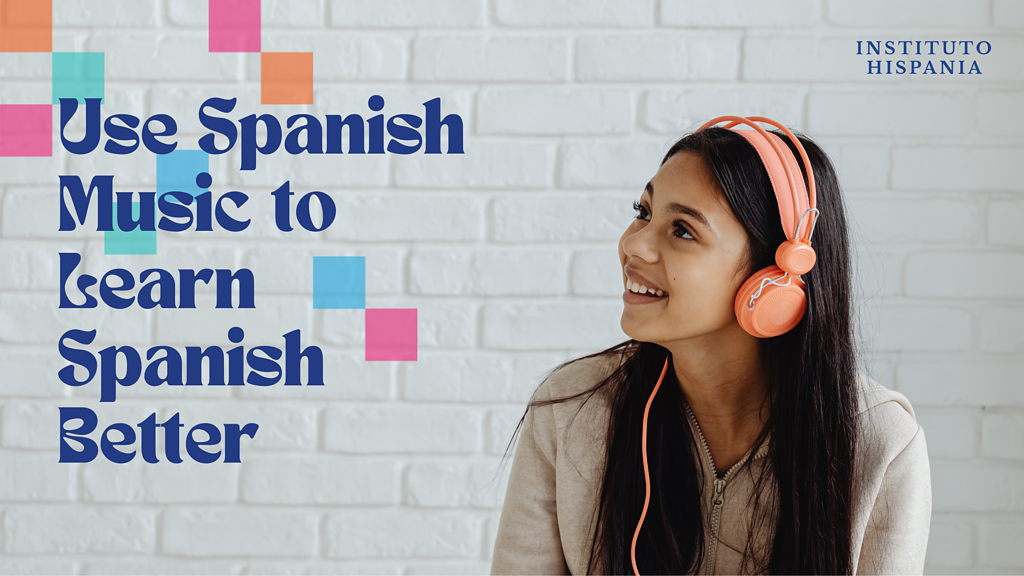If you’re learning how to speak Spanish and you like music, you can combine both to help you on your quest.
Music is a fun and entertaining way to help you learn a language. With rhythmic beats and repetitive patterns, listening to Spanish songs makes it easier to retain words and expressions.
Listening to music evokes a feeling and connects the meaning of words to an emotion, which then becomes memorable.
This makes music a special tool in language learning.

TABLE OF CONTENTS
- About Spanish Music
- So how does Spanish music help you learn Spanish?
- How you can use Spanish music to learn Spanish better
- Final Words on Learning Spanish with Music
About Spanish Music
Spanish is a melodic language with a rich history of diverse music.
It has formed a part of Spanish culture for centuries and developed into various styles and genres.
The history of music in the Spanish language is rich and diverse. It has been a part of Spanish culture for centuries, with various styles and genres developing.
While flamenco and classical guitar are undoubtedly Spain’s most famous musical styles, even today’s pop music includes elements of Spanish passion, rhythm and lyrics to the mix.
Many Latin American countries also have a rich musical heritage, inspired by the customs and traditions of different Hispanophone nations. Their music opens a door for us to experience their culture and gives us insight into different places and its people.
If you are working or intend to be a part of the music industry, you have a good reason to learn Spanish.
With its colourful and passionate culture, and different dialects of Spanish, it is known to be a vital language for business, diplomacy and cultural exchange.
So how does Spanish music help you learn Spanish?
Pronunciation and accent
A delightful and entertaining way to learn the language, Spanish music helps you attune yourself to its pronunciation and varied accents. When you listen to a native singer sing, you get a sense of how they pronounce their words and the rhythm of the language.
Vocabulary
Many songs include lyrics with a wide range of words, phrases and expressions. It can support, expand and improve your vocabulary and your understanding of the language.
Context and authenticity
The songs and lyrics you listen to expose you to an authentic version of the language that you might not encounter in traditional courses. You will learn colloquial expressions that are used in the real world and discover the power of context as a language learner.
How you can use Spanish music to learn Spanish better

1. Use Spanish music as an entertaining tool
When striving to improve your Spanish learning, it helps you understand the language better if you surround yourself with it in various entertaining forms, such as music.
It encourages you to develop your listening and comprehension skills, while increasing your knowledge of vocabulary and correct uses of phrases in context.
With upbeat and catchy rhythms, Spanish songs are easy to listen to on repeat!
2. Sing along with the lyrics multiple times
Singing and repeating song lyrics can help you practice and reinforce correct pronunciation.
This way, you are forced to pay attention to the sounds and rhythm of the words, allowing you to comprehend phonetics better. Tempo and vocals make it easy to memorise new words, phrases and expressions in Spanish songs.
First, listen to the song without looking at the lyrics.
Then hear it again, reading the lyrics while you listen to it.
Look up the meanings of words that you don’t know and understand its context.
Finally, try to sing along with the song. On repeat.
3. Translate the lyrics
Translating Spanish lyrics of a song can help you understand the meaning and context of the words and phrases used.
When translating the lyrics of a song, it’s essential to consider the context of the words and phrases used. It is vital to pay attention to cultural references and colloquialisms that may not have a direct translation into another language.
Lyrics are often poetic, as they often tell a story and express emotions, which can be harder to translate than conversational language.
All in all, translating Spanish song lyrics can be a cheerful and effective way to supplement language learning.
4. Look up the meanings of words you don’t know
If you encounter a word you don’t know, try looking it up to see what it means. This can help you expand your vocabulary and improve your language understanding.
Growing your vocabulary is an integral part of Spanish learning. Acquiring new phrases and their meanings can help you better understand the language and improve your reading, writing, listening, and speaking skills.
There are many ways to look up words. For instance, a dictionary, a translation app, or searching for the word online. It’s crucial to use reliable sources and understand the context in which the term is used.
5. Use music to practice listening comprehension
Music can be a wonderful tool for practicing listening comprehension in a foreign language. It helps differentiate sounds, rhythms, intonations, and how words are expressed.
Try listening to a song without looking at the lyrics and see how much you can understand. This can help you improve your listening comprehension skills. Also, Spanish learners become more familiar with commonly used vocabulary and grammar structures.
Beginners may start with slower-paced songs with simple lyrics. In contrast, more advanced learners may want to challenge themselves with faster-paced songs and more complex lyrics.

Final Words on Learning Spanish with Music
Besides TV serials and films for learning Spanish, music is a great way to learn and practice while having fun.
You can improve your listening comprehension of spoken Spanish while learning new vocabulary.
It helps you understand context better and improve your accents and pronunciation.
Learning Spanish takes time and effort, there are no shortcuts. But incorporating music into your regular routine can make the process more enjoyable, entertaining and rewarding.
¡Buena suerte! (Good luck!)







